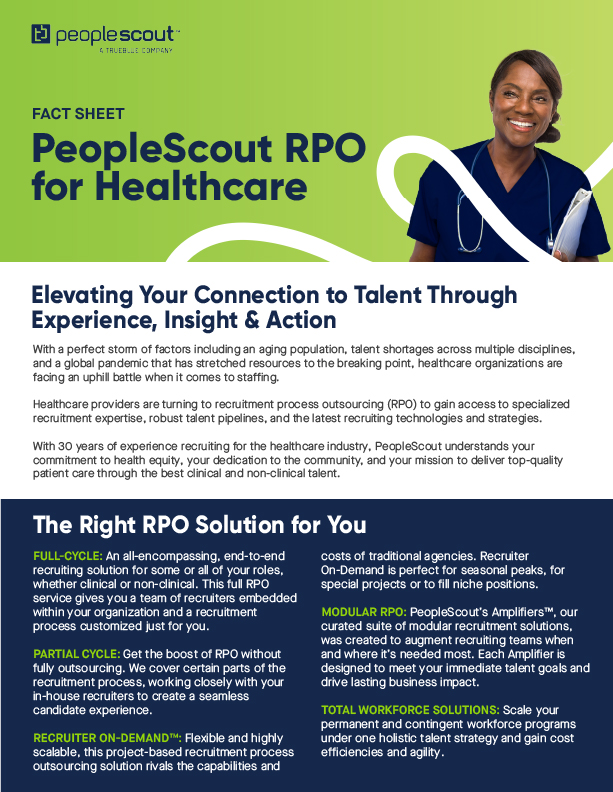PeopleScout RPO Solutions for Healthcare
Hiring the right talent is critical for any healthcare employer looking to stay ahead of the challenges facing today’s healthcare industry.
Download this fact sheet to learn how a recruitment process outsourcing (RPO) from PeopleScout can help your healthcare organization stay ahead of talent scarcity challenges.

Learn more about PeopleScout’s healthcare talent solutions.
Answering Your FAQs on RPO
The terminology and processes involved in the world of RPO may seem unfamiliar. To gain a better understanding of how RPO can help improve your healthcare recruiting program, we answer some of the most frequently asked questions in healthcare RPO.
Q: What Does RPO Stand For?
A: Recruitment Process Outsourcing (RPO) is a type of business process outsourcing (BPO) where an external organization (RPO provider) supports an employer’s talent acquisition function by assuming responsibility for portions or all facets of talent acquisition for some or all of an employer’s hiring needs.
Q: What are RPO Companies?
A: Recruitment process outsourcing companies provide outsourced talent acquisition services for professional and non-professional positions to solve compliance, scalability, cost, quality, or other recruiting challenges. By assuming all or some portions of an organization’s recruitment functions, RPO companies improve recruiting effectiveness, reduce turnover and enable strategic growth.
Q: What is an RPO Provider’s Role During an Engagement?
A: During an RPO engagement, an RPO provider’s team works closely with their client’s talent acquisition and HR department to learn the organization’s long-term talent acquisition strategy, hiring challenges and objectives. The RPO provider then designs a customized recruiting program to support the client’s specific needs.
Q: RPO vs Staffing Agency, What’s the Difference?
A: RPO providers manage a client’s end-to-end recruitment cycle, operating as a trusted partner and advisor. An RPO provider’s primary goal is to deploy a recruitment strategy that attracts, sources and hires high-quality permanent employees. Staffing agencies operate on a more reactive recruitment model, often hiring temporary or temp-to-perm talent on a requisition-to-requisition basis.
Q: What is the Difference Between MSP and RPO?
A: An RPO solution traditionally supports all responsibilities associated with permanent hiring within an organization, such as candidate sourcing, screening, candidate assessments, interviewing, and building talent pipelines. A Managed Service Provider’s (MSP) services are focused on contingent workforce management practices such as payroll management, staffing vendor management, procurement, and contingent workforce compliance expertise.
Q: What Are the Benefits of the RPO Recruitment Model?
A:
- Scalable Recruiting Resources: RPO solutions provide greater recruitment flexibility through an RPO provider’s ability to scale recruitment resources to match a client’s workforce objectives. Scalable recruiting resources are ideal for organizations experiencing fluctuations in hiring volume, rapid growth, or who may need additional support to meet hiring demand.
- A More Consistent and Standardized Recruitment Process: RPO providers can help an organization better organize and execute its recruitment program leading to a more seamless recruit-to-hire process and consistent and predictable results for job seekers and hiring managers.
- Improved Candidate Quality: RPO providers have experience sourcing and hiring talent across all industries and skill types. An RPO provider will home in on more than a candidate’s experience and education to find candidates who best match the client’s company culture and business objectives.
Q: What is Full-Cycle Recruiting and Why is it Best Managed Through An RPO?
A: Full-cycle recruiting or “end-to-end recruitment” is a holistic approach to talent acquisition where an RPO provider is involved in each step of the hiring process. From talent pipelining and delivering talent assessments to interviewing, sourcing, screening, and candidate selection, an RPO provider can support a client’s strategic talent acquisition goals through the entire recruitment lifecycle.
Q: What is Project-Based RPO?
A: Project-based RPO is a type of RPO solution where a client outsources its recruitment needs on a project-by-project basis. Project-based RPO is ideal for organizations looking to meet short-term talent acquisition needs without committing to long-term engagements. Project-based RPO can also help support one-off hiring projects where niche expertise is needed.
Dig into More Healthcare Talent Insights

Nurse Recruitment Strategies to Address the Nursing Shortage
The healthcare industry is facing a severe shortage of nurses and other frontline clinical staff, creating unprecedented challenges for medical facilities across the nation. This crisis, exacerbated by an aging population and the lingering effects of the COVID-19 pandemic, threatens the quality, accessibility and continuity of patient care. Whether healthcare organizations require the recruitment of…

Allied Health Recruiting & Retention Best Practices
With an aging population pushing demand for healthcare ever higher, allied healthcare professionals—physical and occupational therapists, medical laboratory scientists, dietitians and nutritionists, dental hygienists, optometrists, phlebotomists and many more—play crucial roles in the care, diagnosis and treatment of patients. However, healthcare organizations worldwide face significant challenges in recruiting and retaining these vital providers, potentially compromising…

Healthcare RPO: What to Expect from Your Prospective Partner
What to expect for your healthcare RPO partnership.












